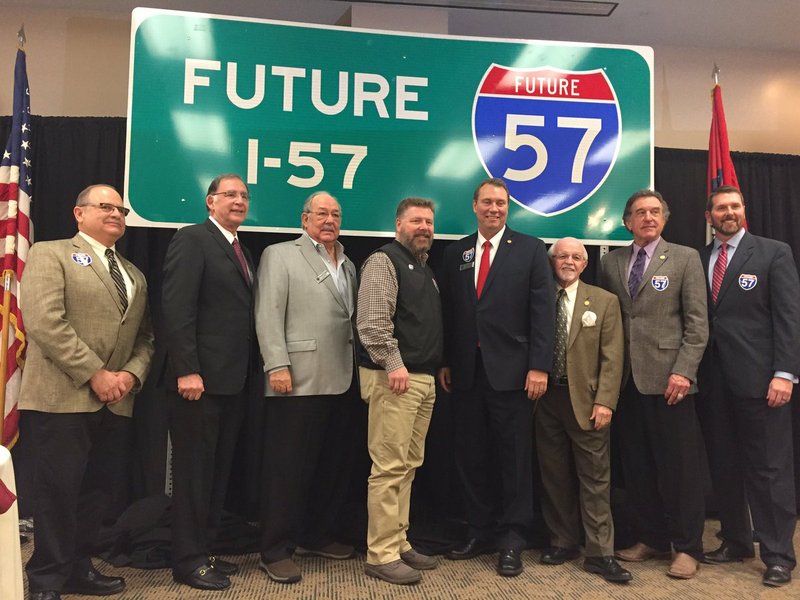SEARCY -- Along U.S. 67, between North Little Rock and Walnut Ridge, state highway employees removed burlap covers from six signs Friday to reveal what the highway eventually will become: Interstate 57.
"Future I-57" is printed on those signs, one of which was unveiled Friday during a luncheon at Harding University.
Currently, I-57 stretches north to south from Chicago to Sikeston, Mo., which is in the far southeast corner of the state.
Supporters of the "Future I-57" project, like U.S. Sen. John Boozman, R-Ark., and U.S. Rep. Rick Crawford, R-Ark., say linking I-57 to Arkansas will spur economic development in northeast Arkansas.
With the support of other Arkansas delegates, Boozman carved out the 120-mile-long Future I-57 designation by inserting a provision into a transportation budget bill for fiscal 2017.
That provision allows the state to request that any piece of U.S. 67 between North Little Rock and Walnut Ridge built to interstate standards be officially added to the federal interstate system as I-57.
Though no money was attached to the provision, having the designation "should put us in a better position to acquire some funding in the future," Boozman said.
Scott Bennett, director of the state Department of Transportation, said he wouldn't "venture to guess" when U.S. 67 will actually become an interstate.
The Future I-57 segment already meets interstate standards, he said. It's a four-lane divided highway, with interchanges instead of intersections.
Still, a gap exists between Walnut Ridge and Sikeston, Mo.
North of Walnut Ridge, U.S. 67 remains a four-lane highway, but it's undivided. In Pocahontas, it turns into a two-lane highway.
That section would either need to meet interstate standards, or a new roadway that is interstate-quality would need to be built, Bennett said. That would cost $350 million to $500 million, he said at Friday's luncheon.
Plus, the Missouri transportation department would need to construct its portion south of Sikeston to the state border.
"Really, the biggest issue for both of us is a lack of funding available for major improvements like that," Bennett said.
Still, he said, Friday's luncheon was "a recognition of the work we've done so far."
Groundwork on U.S. 67 began about 60 years ago. Over those six decades, the state has poured millions into building and widening the highway, including an ongoing project between Jacksonville and Cabot, Bennett said.
In today's dollars, the Future I-57 segment would cost approximately $1 billion to build, he said.
Crawford, who sits on the House transportation and infrastructure committee, said incremental progress, like the Future I-57 designation, is vitally important.
"This is such an economic multiplier," he told a room full of mayors, city council members, county judges and justices of the peace on Friday.
Resolutions of support have been passed Chambers of Commerce in Bald Knob, Cabot, Jacksonville, Lawrence County, Newport, Sherwood and Searcy, according to a news release.
If a town can tell a prospective business that it's near an interstate, Crawford said, it's "one step closer to landing that new plant or expanding the job opportunities in [the] community."
Buck Layne is familiar with the mercurial nature of courting industry. He's president of the Searcy Regional Chamber of Commerce.
Layne said what often happens is a company scouting for a new location will distribute the same questions to dozens of towns across several regions.
What follows is "not so much site selection as site elimination," he said. Very often, Layne said, one of those questions is, how close is the town to an interstate?
"If you're not within 10 miles or less, oftentimes, you're omitted," he said.
By telling industries about Future I-57, they will know that Searcy and other towns are "progressive and aggressive about recruiting," he said.
"In reality, did we really make a big change? No. But there's a perception," Layne said.
Alec Farmer, a state highway commissioner, encouraged people to view the eventual interstate as a regional improvement for a large chunk of the United States.
Farmer reflected on the delight his father, who also was a highway commissioner, took in seeing the White River bridge completed.
"This end result, like the White River bridge 30 years ago, will be worth the effort," he said.
The effort to connect Future I-57 with current I-57 will be considerable.
Right now, the state highway department is conducting environmental studies to determine the route that would run between Walnut Ridge and the Missouri/Arkansas border, Bennett said.
Those studies will be finished in a couple of years, he said. Then, there are the public hearings, design and eventually construction phases, all while coordinating with Missouri officials.
It's possible a new roadway would need to be built north of Walnut Ridge, he said.
An interstate is the safest type of highway because of its restricted access, Bennett said, and residents along that northern portion of U.S. 67 have gotten used to all the access points along the existing route.
Some houses abut the highway.
"People like having their driveways," Bennett said.
Metro on 02/24/2018
